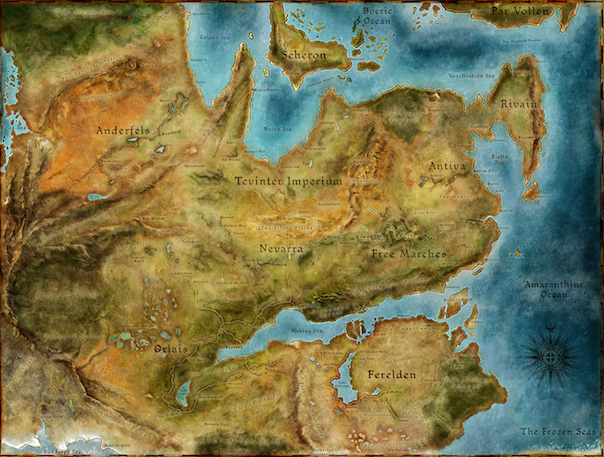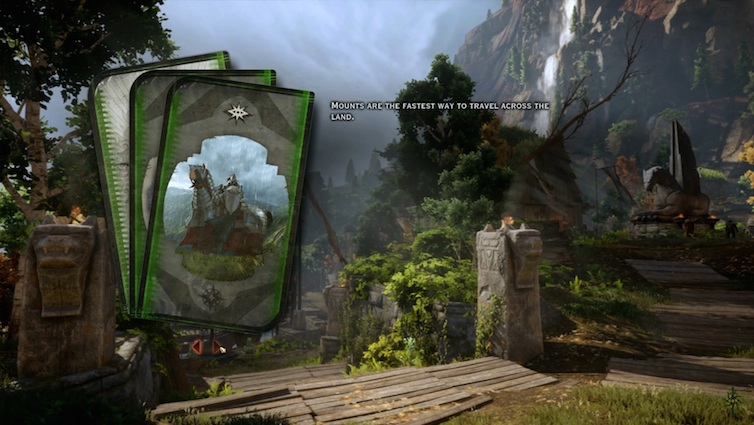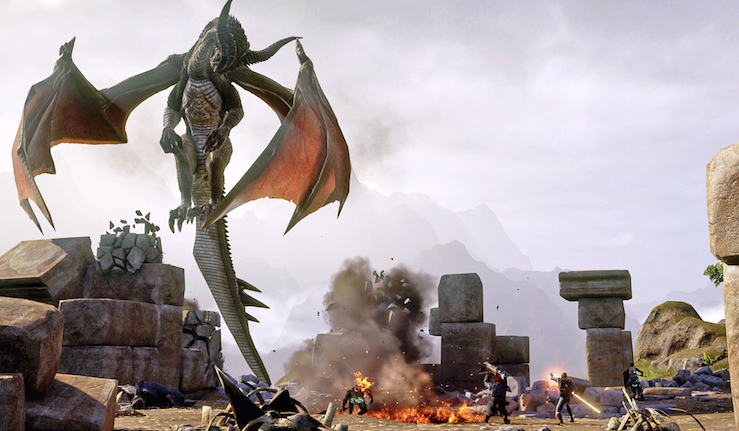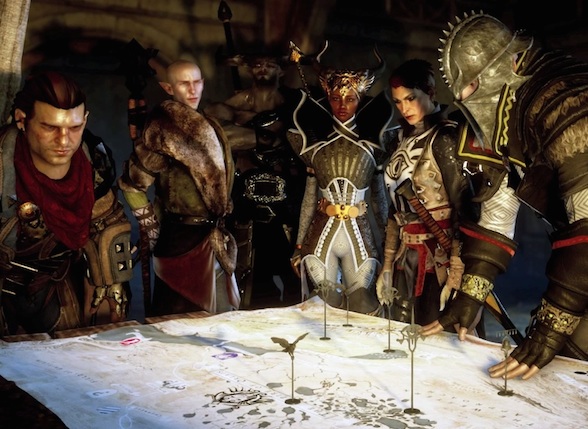Bioware loves dramatic protagonists. The company did the hero of legend in Dragon Age: Origins, the underdog-turned-champion in Dragon Age II Origins–and in Mass Effect, the main character was the savoir of the entire galaxy. How could they hope to create a protagonist to top that? With, it turns out, a hero as potential new messiah, embroiled in a good old battle of the gods. Dragon Age: Inquisition thrives on the dramatic and the epic: in the plot, in the characters, and in the imaginary world of Thedas. The first plot point is an explosion seen on the title screen when “new game” is selected, which sets the story in motion. From then on–throughout more than 100 hours of content–the game is one of wonders both big and small.
Meet the Inquisitor
The Inquisitor is entirely your character. You get to customize everything about her (or him), from her race and background to her appearance, and even her voice. When the game begins, your character is the sole survivor of the aforementioned blast, which happens to have killed hundreds, ruined hopes of peace in a war-torn country, and unleashed its own chaos into the world via a magical scar left in the sky. You were saved by a mysterious figure many believe to be the spirit Andraste, the Jesus-figure in the game’s mythology, giving you a great amount of influence and power whether or not you yourself believe yourself warranting it. It falls to you and your supporters to build up a politically and militarily powerful sect known as the Inquisition, gaining followers and influence as you do so, in order save the world.
Narrative premise out of the way, let’s look at how the game actually holds up; in other words, the Good, the Bad, and the In-Between!
The Good
Thedas Is Really Big and Really Beautiful
There are ten main areas, along with several smaller ones, spanning across the countries of Fereldan and Orlais, and every one of them is impressive in size and aesthetically stunning. Not only is the world big, it also manages to feel varied enough to be interesting while yet cohesive enough to function convincingly as a world. The areas clustered together, such as deserts in Western Orlais, are similar in a way that makes sense with their geographic location but are also unique enough in their design that each is its own interesting experience. In contrast with Dragon Age II, where every single room you entered looked identical to every other one in the game, even the smaller locations are uniquely put together and thus satisfying to explore.
The more-or-less lack of invisible walls and departure from the series’ branching-hallway maps is definitely a contributor to the expansive feeling of the areas. Though invisible walls do exist, they are few and far between. The maps are instead given natural limitations; cliffs that can’t be climbed, sand storms that can’t be crossed, and bodies of water that can’t be forged. When a part of the edge of the map is left open, it will usually lead to a map of the rest of Thedas rather than just act as a blank barrier. The result being that you can go almost everywhere you can see, and in most areas you can see pretty far.

The War Table
Another clever trick Bioware uses to show both the size of the world and the reach of the Inquisition is the war table. This feature is a map, the same map you use to select your destination when traveling, with markers for missions that require your attention. You can select one of your three advisors to handle the situation, and after a certain amount of real-time passes you are delivered a report on how the mission went and any rewards gained.
Although the Inquisitor can themselves only travel to a limited number of locations throughout two countries, the war table can go far beyond that, allowing the Inquisition to still have a presence in every part of the world. By selecting which of your advisors to turn to for any given mission, you can also gain influence in whichever way you choose, be it diplomacy, espionage, or military strength. It’s also a tidy way to bring up nods to past games in the series and individual world states without losing newer players by bogging down with story references and cameos designed for returning players.
The interactions with the war table mostly include reading reports of the problems you have to deal with, reading proposed solutions by your advisors, and then reading reports of the effects once the mission is completed. Basically, it’s a lot of reading. If you don’t bother looking through these reports, it’s probably going to seem like a fairly boring feature. But taking the time to read the short passages, makes the experience more than just clicking and waiting. It puts you in the position of the decision maker and authority figure that your character is supposed to be.
Skyhold
Skyhold is the Inquisition’s base of operations, and it is awesome. You can spend hours just investigating this area alone, trying to figure out how to navigate your castle and finding all the nifty hidden nooks. Your companions and advisors each have their corners where they hang out if you want to talk to them and each corner has a personal touch related to its character. Throughout the game you’ll find or be able to buy various items to personalize Skyhold’s décor in ways that suit your Inquisitor. Beyond that, you will also have a couple opportunities to make upgrades to Skyhold that reflect your priorities and decisions in the game, such as supporting the Templars versus supporting the Mages. This is where you’ll be able to bond with your followers, visit the war table, and upgrade or forge new equipment.
Another interesting aspect found at Skyhold is a feature called Judgement. At several plot points various characters that have worked against the Inquisitor or the law of their respective locations can be captured and sent to Skyhold, where you get to decide their fate for yourself. This is one more way that the game puts the power and authority of the Inquisition directly into your hands and allows you to literally experience it, rather than just telling you about it or even merely showing it. The various options that you have for dealing with the captives is also personalized, and certain options won’t be available to Inquisitors of certain backgrounds or mindsets, or will only be available if certain decisions are made.
The Characters
Bioware’s strength has always been more in its games’ casts than their play mechanisms–and more in its writing than anything else. This remains just as true for Dragon Age Inquisition. The snippets of dialogue between your companions that occur as you run around the world are always either wonderfully entertaining or interesting and insightful, and a new feature allowing your character to join in the conversations helps to solidify the group’s bonds. The companions that you gather are a diverse and lively lot that feel like real people, as opposed to the companions of Dragon Age II, who by the game’s end seemed big archetypes (or, less generously, caricatures) of single big ideas by the end. In this game, they all have distinct personalities and motivations, and while some might not get along as well with you as others, they are all convincing, well-written characters who, the more you play, feel more and more like real people about whom you actually care.
This is helped by the changes made to the approval rating that has been continually evolving throughout the series. While past games allowed you to treat the companions strategically, giving them gifts and leaving them behind on certain missions to get the desired results, interactions in Inquisition are much more natural as no approval meter is displayed, and changes in approval are not assigned numeric value. What the characters think of you is thus more strongly based on your actions in the world and toward them individually.

The Bad
Mounts
The system of mounts introduced in Inquisition is a smart idea that was unfortunately lazily executed. With the exception of the largest dessert area, the mounts don’t maneuver well enough in any of the areas to be more useful than going on foot, and even in the Hissing Wastes they aren’t fast enough to feel much different than simply running. Your companions disappear into black smoke when you mount your steed, just as it itself will do if it’s nearby during combat (as it likely will be, since it’s difficult to avoid being thrown off as soon as you encounter enemies until much later in the game). This both breaks the sense of immersion built up so carefully during the rest of the game and means that you don’t get any of the delightful companion discussions while you’re on your mount. Add to that the fact that there are only really four different mounts in a variety of color swaps and all the exciting potential it the concept might have had disappears.
Our Antagonist
The antagonist of the game peaks very early on in the story, with a legion of crazy followers and an epic first appearance. However, from that first appearance on, the impression of the story’s bad guy continues to fade until the game’s rather lackluster ending. An unknown being seeking to become a God sounds good at the beginning, but the little backstory we are given is not enough to make up for his evil-villain cookie-cutter motives. A good story requires a strong antagonist, one who thinks he himself is doing the right thing even if we, as the audience, can clearly tell that he is not. We see this in both of the first two games, but Inquisition’s biggest bad guy isn’t much but a tired archetype, making his followers even more shallow and unbelievable still.
Almost to add insult to injury, there are clear hints throughout the game of a darker, more interesting conflict brewing just beneath the surface. Though the story is cool on its own, I almost felt like it was little more than a place-holder for the slow development of a series-long conflict which has yet to manifest.
The Loading Screen
By far the pettiest of my Inquisition complaints is how the loading screen is handled. When switching areas, the screen displays three tarot cards and information from the game codex for players to read and learn about the world while they wait. While this is a cool idea, it’s not well executed. The codex entries shown are usually fairly long, and the player only has time to read a few sentences at most before it disappears . . . only to be replaced by another plain black loading screen? Really?
The In-Between
Combat
The battle system in this game is interesting. The lack of any healing spells in favor of a set number of health potions is a daring but successful switch from past games, allowing for more variety in party combinations and forcing more of a focus on defense rather than support. There’s a wide variety of new ways to experiment with specializations and party dynamics and a lot of potential for any play-style. The pause-and-command tactical view can be helpful, and is even entirely necessary for tougher battles and higher difficulty settings, but it definitely brings the flow of the battle to a halt as you issue commands to your teammates, resume time again as they carry out your orders, and then repeat.
The biggest negative in regards to the combat for me was the tactics screen in Inquisition. For a game that fixed so much from its predecessors and advertised the combat system so heavily, the tactics screen here is a surprising and disappointing step down. Whereas in past games it was possible to customize a lengthy list of “if-then” statements dictating every followers’ action during combat, Inquisition limits the behavior set of characters to (1) how often they use heath potions and moves and (2) their default target, resulting in many decisions being left to an AI that is, frankly, not that great. In easy battles it may not matter, but in many scenarios it is very jarring to have to constantly try to micromanage all of your companions for the sake of efficiency.

Dragons
Living up to the series’ title, the dragons in Inquisition are (finally) plentiful and suitably epic. They’re just as terrifying as they should be until you’re at a high enough level, and they’re such a distinct part of the environments that it’s almost a shame to kill them. That said, after taking a few of the giant beasts down, the battles do all start to feel the same. There’s very little diversity in the combat with the dragons except for each dragon’s elemental resistances/weaknesses, and though the attempt to make dragons feel different from other enemies by breaking them up into parts has potential it ultimately never seems to matter much.
Crafting
The crafting system of Inquisition is another new feature to the game, and it has it good parts and bad parts. You can craft some really powerful items, easily more powerful than anything that could be found through looting. You get to pick out what materials to put in different statistic slots on the crafting screen with each type of material having different benefits, so you get to designate whether you want your armor to have more melee defense/magic resistance/etc. The bad, on the other hand, is that the only effective way to gather all of these materials is to walk around, which is a tedious and time consuming process. Also, the fact that the chosen materials also affect the appearance of what you are crafting occasionally leads to choices such as whether running around in bright pink and green armor is worth the higher stats. You also get to name everything you craft, however, which almost makes up for the fashion problems.
Roundup
Dragon Age: Inquisition is more than a fixed version of the first two games. It holds onto the best parts of each of its prequels and improves upon the worst, but most importantly it throws in its own unique flair, which ultimately re-shapes the entire experience. There are endless moments, from the epic scenes that give chills to the small conversations that warm the heart, which all work together to make this an amazing game. The hundreds of hours of content are not just busy-work running around gathering (mostly not, anyway), but are filled to the brink with an unbelievable amount of unique and exciting things to do and features to play with. While it certainly has some issues, they’re nothing compared to the immersive, expansive, emotional world that is Thedas.






Recent Comments